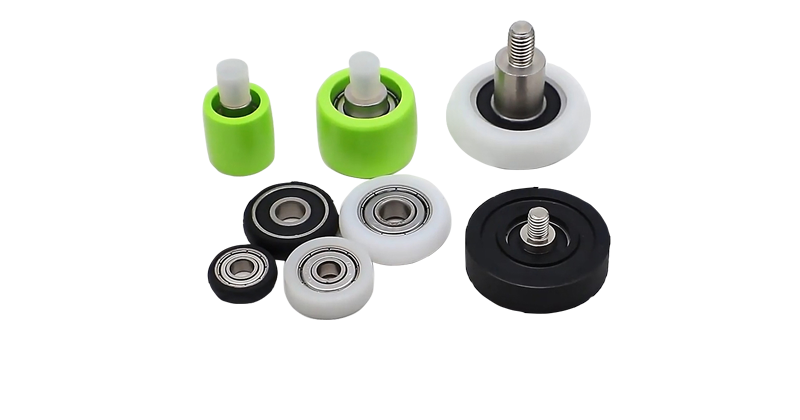86-15820855246(WhatsApp)
info@semeimachinery.com
 SEMEI Wheel Bearings : What are the characteristics of rubber-coated bearings?
SEMEI Wheel Bearings : What are the characteristics of rubber-coated bearings?Rubber-coated bearings are a specialized type of bearing designed to enhance performance and durability in specific applications. The rubber coating provides additional benefits beyond those of traditional metal bearings. Here’s a detailed overview of the features and advantages of rubber-coated bearings:
Vibration Damping:
Reduces Noise and Vibration: The rubber coating helps to absorb and dampen vibrations, reducing noise levels and improving the overall smoothness of operation.
Enhanced Comfort: This feature is particularly important in applications where user comfort is crucial, such as in medical equipment or precision machinery.
Corrosion Resistance:
Protects Against Corrosion: The rubber coating acts as a barrier against moisture, chemicals, and other corrosive agents, extending the lifespan of the bearing.
Suitable for Harsh Environments: This makes rubber-coated bearings ideal for use in marine, agricultural, and industrial settings where exposure to corrosive elements is common.
Improved Load Distribution:
Even Load Distribution: The rubber layer helps to distribute loads more evenly across the bearing surface, reducing stress concentrations and improving load-carrying capacity.
Reduced Stress Concentration: This can lead to better fatigue resistance and longer bearing life.
Self-Lubricating Properties:
Reduced Friction: The rubber coating can act as a lubricant, reducing the need for external lubrication and maintaining low friction.
Lower Maintenance: This feature reduces maintenance requirements and operational costs.
Sealing and Containment:
Prevents Contamination: The rubber coating helps to seal the bearing, preventing contaminants from entering and causing damage.
Retains Lubricants: It also helps to retain internal lubricants, ensuring consistent performance over time.
Flexibility and Compliance:
Adapts to Misalignments: The rubber layer allows the bearing to adapt to minor misalignments and irregularities in the mounting surfaces, reducing the risk of premature failure.
Improved Tolerance to Shock Loads: The flexibility of the rubber coating can absorb shock loads, making the bearing more resilient to sudden impacts.
Temperature Resistance:
Wide Operating Temperature Range: Depending on the type of rubber used, these bearings can operate effectively over a wide range of temperatures, from low to high.
Stable Performance: The rubber maintains its properties and performance even under varying temperature conditions.
Nitrile Butadiene Rubber (NBR):
Oil and Fuel Resistant: Suitable for applications involving oils, fuels, and other hydrocarbons.
Good Temperature Range: Operates well from -40°C to 100°C.
Elastomer (EPDM):
Weather and UV Resistant: Ideal for outdoor applications where exposure to sunlight and weather is a concern.
Wide Temperature Range: Operates from -40°C to 120°C.
Silicone Rubber:
High Temperature Resistance: Can operate at very high temperatures, up to 200°C.
Low Temperature Flexibility: Maintains flexibility at very low temperatures, down to -60°C.
Fluorocarbon Rubber (FKM):
Chemical Resistance: Highly resistant to a wide range of chemicals and solvents.
High Temperature Stability: Operates effectively up to 200°C.
Automotive Industry:
Suspension Systems: Used in shock absorbers and suspension components.
Engine Components: Used in engine mounts and other vibration-dampening applications.
Agricultural Equipment:
Tractors and Harvesters: Used in components exposed to harsh environmental conditions.
Implement Attachments: Used in attachments that require corrosion resistance and vibration damping.
Construction Equipment:
Excavators and Loaders: Used in pivot points and other moving parts.
Vibratory Compactors: Used in components that generate and transmit vibrations.
Industrial Machinery:
Conveyor Systems: Used in rollers and guides to reduce noise and vibration.
Pumps and Compressors: Used in components that require sealing and corrosion resistance.
Medical Equipment:
Imaging Devices: Used in components that require smooth, quiet operation.
Surgical Equipment: Used in components that need to be sterilized and corrosion-resistant.
Rubber-coated bearings offer a range of benefits that make them suitable for a variety of demanding applications. Their ability to reduce noise and vibration, resist corrosion, and improve load distribution makes them a valuable choice in industries where reliability and performance are critical. When selecting a rubber-coated bearing, it is important to consider the specific requirements of the application, including environmental conditions, load types, and temperature ranges, to ensure optimal performance and longevity.
